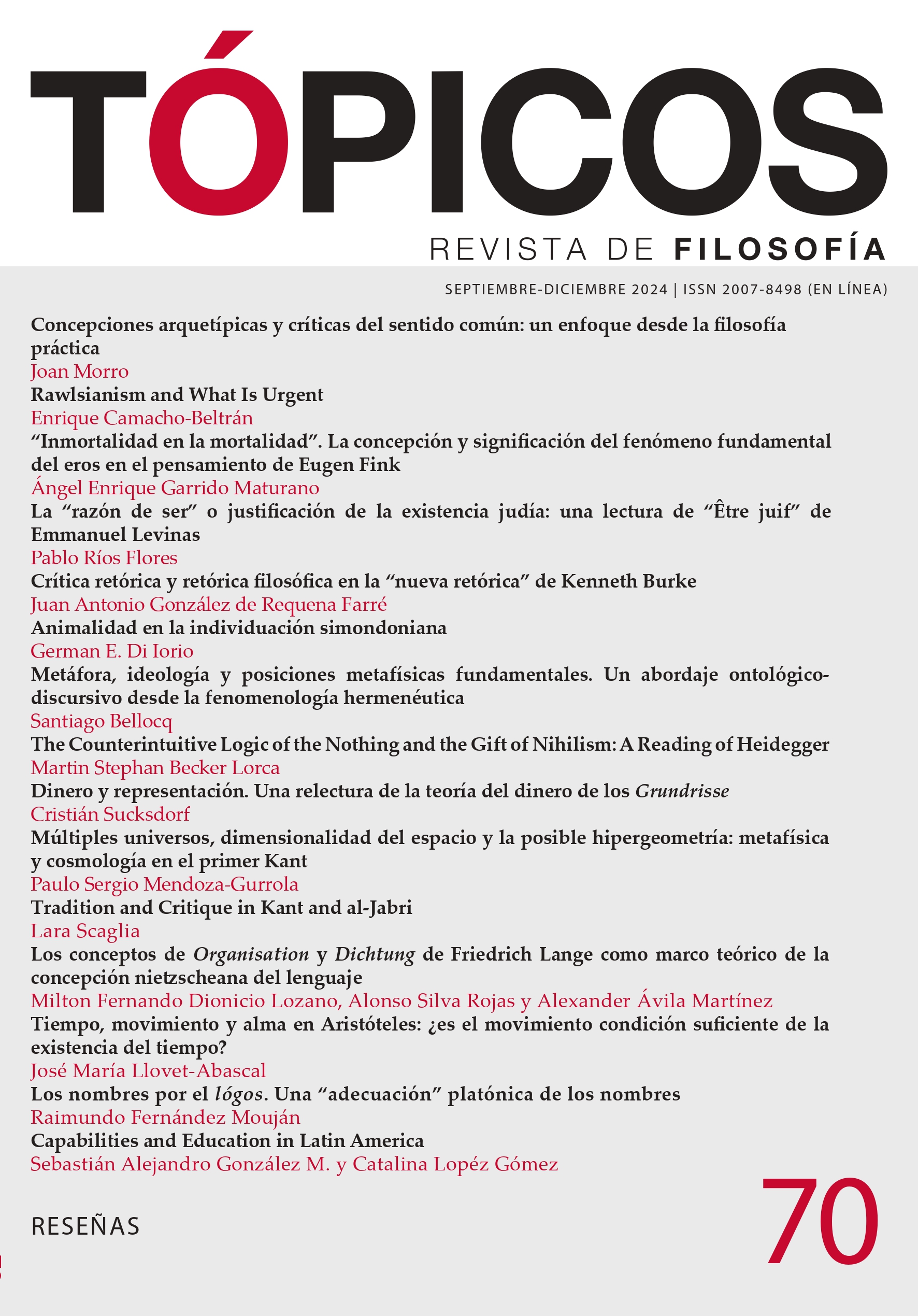Publicado 2024-08-15
Palabras clave
- animalidad,
- Simondon,
- individuación
Derechos de autor 2024 Tópicos, Revista de Filosofía

Esta obra está bajo una licencia internacional Creative Commons Atribución-NoComercial-SinDerivadas 4.0.
Cómo citar
Resumen
Este escrito explora La individuación a la luz de las nociones de forma y de información de Gilbert Simondon, tomando como hilo conductor la cuestión de la animalidad. Se analiza si en dicho libro hay un corte antropológico que permita separar tajantemente la individuación del hombre de la de los otros animales. La hipótesis inicial es que tal concepción de la antropogénesis, con el excepcionalismo humanista y el especismo que implica, resulta incompatible con el sistema allí desplegado por Simondon. A lo largo del trabajo se enfatiza que la ontología de Simondon, con sus ambigüedades y tensiones en torno a la cuestión, exige pensar otro concepto de “animalidad” que aquel que hereda de la tradición filosófica contra la que se enfrenta.
Referencias
- Bardin, A. y Raimondi, F. (2016). Del hombre a la materia. Simondon a la luz de Marx y Althusser. M. Starcenbaum (trad.). Demarcaciones. Revista Latinoamericana de Estudios Althusserianos, 4, 116-132. URL: https://revistademarcaciones.cl/wp-content/uploads/2023/N4_2016/10.Bardin-y-Raimondi.pdf.
- Barthélémy, J.-H. (2005). Penser l’individuation : Simondon et la philosophie de la nature. L’Harmattan.
- Barthélémy, J.-H. (2016). De lo muerto que invade lo vivo: sobre la actualidad de la ontología simondoniana. M. Starcenbaum (trad.). Demarcaciones. Revista Latinoamericana de Estudios Althusserianos, 4, 49-56. URL: https://revistademarcaciones.cl/wp-content/uploads/2023/N4_2016/4.Barthelemy.pdf.
- Bórquez, Z. (2016). Humanismo y tecnicidad. Entrevista con Jean-Hugues Barthélémy. Demarcaciones. Revista Latinoamericana de Estudios Althusserianos, 4, 69-77. URL: https://revistademarcaciones.cl/wp-content/uploads/2023/N4_2016/6.Entrevista-Barth%C3%A9l%C3%A9my.pdf.
- Chateau, J.-Y. (2008). Le vocabulaire de Gilbert Simondon. Éditions Ellipses.
- Chateau, J.-Y. (2016). Presentación. En G. Simondon, Dos lecciones sobre el animal y el hombre. (pp. 9-25). P. Pizarro (trad.). La Cebra.
- Combes, M. (2017). Simondon: una filosofía de lo transindividual. P. Ires (trad.). Cactus.
- Durán, C. y Henríquez Ruz, F. (2018). La vida diferente de sí. Simondon y la (dis)continuidad entre lo inerte y lo viviente. Hybris. Revista de Filosofía, 9(1),13-34.
- Fagot-Largeault, A. (1994). L´individuation en biologie. En G. Châtelet (ed.), Gilbert Simondon. Une pensée de l´individuation et de la technique. (pp. 19-54). Albin Michel.
- Heredia, J. M. (2012). Los conceptos de afectividad y emoción en la filosofía de Gilbert Simondon. Revista de Humanidades, 26, 51-75. URL: https://revistahumanidades.unab.cl/index.php/revista-de-humanidades/article/view/285.
- Heredia, J. M. (2018). El carácter problemático y auto-problemático del individuo según Simondon. Revista de Psicología Universidad de Antioquia, 10(1), 45-68. DOI: https://doi.org/10.17533/udea.rp.v10n1a02.
- Heredia, J. M. (2019). Simondon y el problema de la analogía. Ideas y Valores, 67(171), 209-230. DOI: https://doi.org/10.15446/ideasyvalores.v68n171.65307.
- Heredia, J. M. (2022). Mundología: Jakob von Uexküll, aventuras inactuales de un personaje conceptual. Cactus.
- Merleau-Ponty, M. (1995). Le concept de nature, 1957-1958. L’Animalité, le corps humain, passage à la culture. En M. Merleau-Ponty, La nature. Notes. Cours du Collège de France. (pp. 167-259). Seuil.
- Merleau-Ponty, M. (2003). El mundo de la percepción. Siete conferencias. (pp. 35-45). V. Goldstein (trad.). Fondo de Cultura Económica.
- Morizot, B. (2011). La néotenie dans la pensée de Gilbert Simondon. Ontogénèse d’une hypothèse. Cahiers Simondon, 3, 109-129.
- Merleau-Ponty, M. (2016). Pour une théorie de la rencontre. Hasard et individuation chez Gilbert Simondon. Vrin.
- Merleau-Ponty, M. (2020). Tras el rastro animal. F. Gelman Constantin (trad.). Ediciones Isla Desierta.
- Penas López, M. (2014). Individuación, individuo y relación en el pensamiento de Simondon. [Tesis doctoral, Universitat Autònoma de Barcelona-Université Toulouse-Jean Jaurès]. Dipòsit Digital de Documents de la UAB. URL: https://ddd.uab.cat/record/141589.
- Petit, V. (2009). L’individuation du vivant. Sur une intuition simondonienne restée ignore. Cahiers Simondon, 1, 47-75.
- (2010). L’individuation du vivant (2). Génétique et ontogenèse. Cahiers Simondon, 2, 53-80.
- Simondon, G. (2007). El modo de existencia de los objetos técnicos. M. Martínez y M. Rodríguez (trads.). Prometeo.
- Simondon, G. (2012). Curso sobre la percepción (1964-1965). P. A. Ires (trad.). Cactus.
- Simondon, G. (2013). Imaginación e invención (1965-1966). P. A. Ires (trad.). Cactus.
- Simondon, G. (2015). La individuación a la luz de las nociones de forma y de información. P. A. Ires (trad.). Cactus.
- Simondon, G. (2016). Dos lecciones sobre el animal y el hombre. P. Pizarro (trad.). La Cebra.
- Stiegler, B. (2015). La prueba de la impotencia: nanomutaciones, hypomnemata, gramatización. En J. Blanco, D. Parante, P. Rodríguez y V. Vaccari (eds.), Amar a las máquinas. Cultura y técnica en Gilbert Simondon. (pp. 139-170). A. A. Ré (trad.). Prometeo.
- Zanfi, C. (2008). Gilbert Simondon y la extraña parentela entre el animal y el hombre. [Reseña de Dos lecciones sobre el animal y el hombre, de G. Simondon] F. Zanfi (trad.). Riff Raff: Revista de Pensamiento y Cultura, 38, 12-18.





